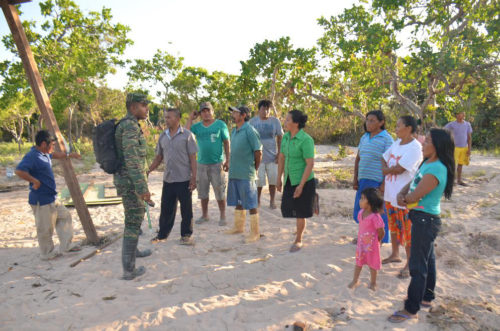While efforts to determine the extent of recent flooding and its impact on communities in Region Seven (Cuyuni-Mazaruni) are still in progress, the Ministry of the Presidency has said that Phillipai was hit by heavy rain that fell trees, as well as caused landslides.
The ministry, in a press statement issued on Friday evening, said while water has receded from some areas and mostly farmlands are now severely affected, Phillipai is reported to have experienced storms with very high winds during the previous period of heavy rainfall, which resulted in the felling of trees in the area. Additionally, it said the community has suffered several landslides, resulting in several trails through the village, being covered in slush.
Reports received indicate that the airstrip in Paruima has been flooded. Additionally, erosion of the river bank has started to occur.
The Civil Defence Commission (CDC), however, has already deployed 142 relief hampers to its Forward Operations Centre at Kamarang for distribution to the communities even as it is preparing child-specific hampers for distribution to infants and school-aged children in the flooded communities.

The Regional Democratic Council, which worked alongside the CDC earlier this year to complete the Regional Multi-Hazard Preparedness and Response Plan, has activated its Disaster Risk Management Committee and has been actively responding to the flooding in the area.
A hazard
Meanwhile, the ministry said the development of a long-term plan to address the infrastructural damage inflicted on villages in Region Eight (Potaro-Siparuni) affected by recent floods is underway, following the completion of assessments carried out by the Guyana Defence Force (GDF) Engineer Corps and the Guyana Water Incorporated (GWI).
According to the statement, both agencies, which were dispatched to the flood-affected communities in the region have completed their assessments and are preparing their reports for submission to the administration for action.
Two engineers from the GDF as well as technical staff from GWI, it was noted, were deployed by the government to conduct an assessment of the damaged roads and buildings and to facilitate water quality testing and set up purification systems, with a view to determining the long-term response that will be required from the state. Their deployment came shortly after last Sunday’s visit to the villages of Itabac and Kanapang by Minister of State Joseph Harmon, to whom residents directed their concerns as it related to the damage to the road between Kanapang and Itabac.
The road, along with the school building and houses, which were badly damaged, has since been assessed by Captain Daniel Seeram, Officer Commanding 42 Field Engineers Company and Captain Jocelyn McAllister, Engineering Officer.

According to the statement, the initial assessments, Seeram said, were made for general infrastructure in the villages, approaches to the villages, the trails and bridges, along with any damage done to homes and government buildings. “One major concern was the bridge and that is totally displaced and dilapidated. The rise in the water level and the force of the water shifted the bridge off of its trestles making it impassable by vehicles and other transportation. The trails between the bridge and Itabac are also in a deplorable state. This is a hazard for persons moving between the villages. In Kanapang, also, the airstrip is unserviceable, resulting in planes landing in the ball field,” Captain Seeram was quoted as saying.
Contaminated
Meanwhile, a team comprising representatives from the Ministry of Public Health, the Ministry of Indigenous Peoples’ Affairs and the GWI visited the affected communities to conduct further assessments of the damage and impacts to housing, agriculture and water.
Thus far, GWI said that the water system in the community of Kanapang was reported to have been contaminated, with the water in the well now having a very discoloured appearance. The well at Itabac, on the other hand, is currently unserviceable as the solar panel, which powers it, was struck by lightning during a recent thunderstorm.
Hinterland Engineer Jamal Duncan was quoted as saying in the statement that GWI has taken note of all the issues identified and will be working to address these in the coming weeks.
Offering some insight on the health situation in the region, Coordinator for the Hinterland Regions at the Ministry of Public Health Michael Gouveia said that the ministry has been working with the villages to establish care instructions, which can guard against waterborne diseases. He noted that while there is no health crisis at this time in the region, the ministry is ensuring that prevention measures are taken seriously.
The health team in the region comprises doctors, nurses, immunisation officers, environmental and health officers, veterinarians, surveillance officers and an official from the Pan American Health Organisation.
The ministry also said residents offered praises for the support received in wake of what has been a devastating situation to many. One such resident was Karsha Lewis, of Kanapang, who is reported to have extended gratitude on behalf of the village for the efforts made by the government.
“The government has been doing a good job in sending food stuff and other relief for the people here and it has been very good so we want to say thanks. For everyone here, particularly [those] who have lost all that they had, it means a lot and the village of Kanapang says thank you,” she said.
Yaron Jaron, another resident, said that while he has lost everything, he is hopeful that the government will provide the necessary assistance to help him to rebuild. “The government has been helping and I would be appreciative of the government’s help to rebuild,” he said.








